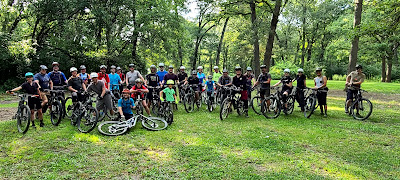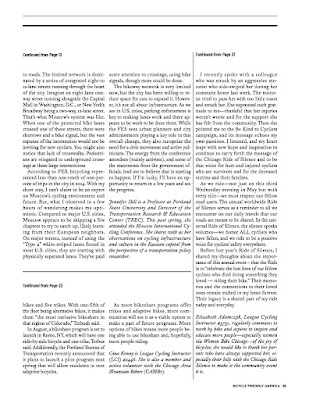.jpg) |
| A small group of riders at the start of their route in July. A Fun, Social, Beginner-Friendly ride. |
Perhaps you may wonder why you should invest time into creating a group ride when you can ride on your own. Many discover that they start to ride faster after being a part of a group ride. The experiences and expertise of group ride members can also help you learn new line choices and other tips that make you a better rider. If you are already one of those better riders, you may pass along those hard-earned tips, tricks, and wisdom to others, which in turn tends to strengthen/reinforce your existing abilities. Most of us enjoy the camaraderie of group rides and they can also strengthen your community and introduce others to the sport.
However …
Not all of us are lucky enough to ride where groups are already established. If your area does not already have a group ride, starting one is not a piece of cake, but it’s not difficult either.
Investigate, Question & Then Do It
If you are not aware of a group ride in your area, first ask around. Perhaps the local bike club or bike shop is already hosting one but is just not publicizing it well enough. Do the same with any area local cross-country ski or running club as many of these groups enjoy more than one silent sports discipline. And you may find that, even if these businesses or groups may not have an existing, organized group ride, they may be considering starting one and you can become part of a team effort.
To start the process of starting a regular group ride, pick a day for the ride and a frequency. Did your trail system used to have group rides? My local trail system, Palos, used to have large Wednesday group rides; so, I picked that day.
Are there other nearby trail systems that have group rides on a different day? If so, you will likely want to avoid those to allow both rides to grow. For the Chicago Area Mountain Bikers, there are already group rides on Mondays at Saw Wee Kee, Tuesdays at Raceway Woods, and Thursdays at Paul Douglas.
Weekly rides do make it easier for people to know when your rides are; and, of course, there are other benefits to regularly scheduled rides. "Weekly group rides make it easy for me to ride consistently,” said Linda Chandler, of Oak Park, IL, “which has helped me build skills and gain confidence on the trails."
However, there are other options such as every other week or once a month, with it being either the first Monday of the month or the last Thursday of the month as examples.
One of the most difficult parts of starting a group ride may be picking the time for the ride. People tend to get off work or otherwise may be able to get to the trail system at different times ― finding the time that works for the majority of people can be challenging.
You can consider having a poll on social media, asking around, or even trying a couple of different times. If your mountain bike staging area has a short loop leading from it, you can also have a start time, ride the loop, and then pick up any newcomers on the way through staging again.
Spread the News
Once you have a day, time, and location, you will want to begin promoting the ride. Social media can be an excellent way to do this. Posts with the details, updates/reminders (particularly when it comes to trail conditions), and photos/videos from past rides can all help generate interest.
I chose to publicize them as “fun, social, beginner-friendly” rides. We had all different levels come out but listing it that way encouraged many to try a group ride for the first time. Other options to promote the rides are seeing if the local mountain bike club or other silent sports discipline club will include the ride in their email blasts, on their website, or via creating a Meetup event.
You may also want to post reminders of the ride. I noticed that I would receive multiple messages and notifications if I neglected to post a reminder for the ride. While your cycling community may not feel a need for reminders, still, there are times when you will want to consider reminders if the trail conditions are questionable, perhaps due to a recent storm/treefall or expected rain as examples.
Rules Rule
I would suggest requiring helmets and making sure everyone brings water with them. You may want to speak briefly before the start of a ride if you have any ground rules. For me, I make it clear that I wanted people to let me know if they were dropping off so we did not spend all night looking for them. I also make it clear that I was happy to stop for us to catch our breath but also if there was a log or other feature that they wanted to try.
If people are new or are just not familiar with mountain bike etiquette, consider passing on information such as how to check for trail conditions, trail etiquette tips, and practices such as only riding sanctioned trails and only during permitted times to keep a good relationship with the landowner. The more of us who ride responsibly, the easier it will be to start working with municipalities, businesses, and others to help with the construction of a new trail or hosting a race.
Group rides will run smoother if you are able to have one person lead the group and a sweep, at the end. I was lucky to have an experienced rider, Chuck Gentile of Hickory Hills, IL, be my sweep for nearly all of my rides. “This year will be my 50th year riding the area's trail systems,” Gentile said. “As a sweep rider, most of the time it is satisfying to encourage other riders to join up on group rides, ensure them that they are welcome, give them the confidence they need to ride with others, and improve their fitness and skills to enjoy the trails for years to come.”
Decide if the ride will be no-drop – meaning no riders are left behind. If no-drop is your choice, an effective way to make this happen successfully is to stop at intersections to make sure no riders have gotten lost, fallen too far behind, are having mechanical problems, or need to rest or even leave. While these group rides are slower, with more stops, they do ensure no one gets lost and tend to make the ride more enjoyable for all.
Après Group Ride
Consider posting photos and videos after each ride. (Of course, make sure to take these images during the ride!) These posts will help promote the rides. And people also are usually thrilled to have a video of them riding a low skinny for the first time. I found the start of the ride to also be the best time to get a photo, before we broke into groups or someone needed to leave early.
After seeing videos of our group playing on large log piles and skinnies, the ride began to attract even more as well as a more diverse group of riders. More riders and more types of riders are, ultimately, a great thing. Problems can arise from having one large group of riders on the trail at the same time. A large group, for example, is harder to manage. Also, and perhaps more importantly, a large group of riders can cause issues for other people using the trail – whether that be riding, running, hiking, walking, or riding horses. Being courteous, respectful, and even deferential to other, multi-use trail folks can help your riding group achieve the reputation needed to accomplish ride-related projects.
Divide & Conquer
If your rides gain traction, you will likely have to begin to decide when to split up your group. While there is not necessarily an ideal number of riders per group, as you notice a group becoming too large to manage, or if the increased number seems to be detrimentally affecting the ride’s quality, enjoyment, and/or impact on other trail users, it’s likely time split it up.
To do so, you can choose to have a faster group and a slower group, or perhaps a more advanced and more beginner group, or split the group based on routes with different trails.
Having some of the regular riders offer to lead and sweep one of the groups is recommended.
The Palos rides went from only four riders for the first one to a high of more than 30, with the group consistently having at least a dozen riders by the end of the season. I led the slower group while encouraging our merry band to ask questions. As a result, I would occasionally give some basic tips such as having level pedals, and encourage them to try things they may not have even noticed before, such as optional lines over log piles or skinnies. Optional features should always remain optional, of course, as you do not want to encourage people to ride something beyond their abilities that could result in discouragement or injury. For the skinny at Palos, it was relatively low-consequence in that the skinny was short enough so that people could roll off and we had enough people in the group to assist.
Group Riding with the Flow
As summer ends and fall progresses, you will likely have to start bumping up your start time. For the Palos rides, once daylight savings time started, we put the ride on hiatus until spring. It also helps to have several regulars who are willing to host a ride if you are out of town or ill.
While starting your own group ride can seem like some work, the results are usually rewarding. I ride nearly every day and consider myself a pretty skilled rider. These group rides ended up being the highlight of my week. I enjoyed the social aspect and encouraging more people to ride. As a volunteer trail worker, I found it wonderful to be able to explain trail conditions and trail etiquette to riders as well as talk about upcoming trail days and events. My favorite aspect of group rides, however, may have been realizing that there were now quite a few more people who were seeking out the optional lines to go over logs, rocks, and roots.
Give yourself a chance, start a group ride, and discover what among the many benefits is your favorite. Check out Group Ride videos: veganbiker.blogspot.com.
.jpg) |
| In October, at one of the markers at Palos for where the first nuclear reactor was rebuilt during a break at one of the last Fun, Social, Beginner-Friendly rides for the season. |
.jpg)



















